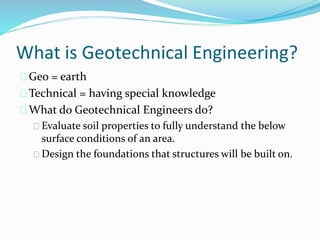Geotheta - An Overview
Geotheta - An Overview
Blog Article
The 15-Second Trick For Geotheta
Table of ContentsGeotheta Fundamentals ExplainedIndicators on Geotheta You Need To KnowThe smart Trick of Geotheta That Nobody is Talking AboutThe Main Principles Of Geotheta 3 Easy Facts About Geotheta Described

They conduct site investigations, gather examples, do research laboratory examinations, and analyze data to assess the suitability of the ground for building jobs - Tailings Engineer. Based upon their searchings for, geotechnical designers supply referrals for foundation style, slope stability, keeping structures, and mitigation of geotechnical hazards. They collaborate with other professionals, such as architects, architectural designers, and building teams, to guarantee that geotechnical considerations are incorporated into the general job layout and execution
By analyzing the actions and properties of dirt and rock, they can determine possible geotechnical dangers such as landslides, soil settlement, or incline instability. Their expertise helps prevent failings or mishaps that might endanger lives and residential or commercial property. Here are some comprehensive tasks and obligations of a geotechnical engineer: Website Investigation: Geotechnical designers conduct site investigations to collect data on subsurface problems.
They translate the data to recognize the buildings and actions of the soil and rock, including their strength, leaks in the structure, compaction qualities, and groundwater conditions. Geotechnical Analysis and Layout: Geotechnical designers examine the information gathered throughout website examinations to examine the stability and suitability of the website for building jobs. They carry out geotechnical calculations and modeling to examine elements such as birthing capability, negotiation, slope security, side earth stress, and groundwater circulation.
The Basic Principles Of Geotheta
Foundation Design: Geotechnical designers play a crucial role in creating structures that can securely support the desired structure. They examine the soil conditions and lots needs to establish the ideal structure type, such as superficial foundations (e.g., grounds), deep structures (e.g (https://es.quora.com/profile/Ian-Hammond)., piles), or specialized strategies like dirt improvement. They take into consideration factors such as settlement limitations, bearing capacity, and soil-structure communication to create optimal structure layouts
They assess building strategies, monitor website activities, and perform field assessments to verify that the design recommendations are followed. If unanticipated geotechnical concerns occur, they assess the circumstance and supply suggestions for removal or changes to the layout. Danger Assessment and Reduction: Geotechnical engineers evaluate geotechnical dangers and risks connected with the project site, such as landslides, liquefaction, or dirt erosion.

Cooperation and Interaction: Geotechnical designers work very closely with other specialists associated with a task, such as architects, architectural engineers, and building and construction teams. Efficient interaction and partnership are vital to incorporate geotechnical considerations into the total project layout and building procedure. Geotechnical engineers supply technical know-how, solution questions, and ensure that geotechnical needs are satisfied.
Geotheta - An Overview
Below are some kinds of geotechnical designers: Foundation Engineer: Structure designers specialize in developing and analyzing structures for frameworks. They evaluate the dirt problems, tons demands, and website characteristics to determine the most appropriate foundation kind and layout, such as superficial structures, deep structures, or specialized methods like stack foundations.
They evaluate the factors affecting incline security, such as dirt residential or commercial properties, groundwater conditions, and incline geometry, and create strategies to stop incline failings and alleviate risks. Earthquake Designer: Quake designers concentrate on evaluating and designing structures to hold up against seismic pressures. They evaluate the seismic risk of a site, evaluate soil liquefaction capacity, and develop seismic layout standards to make sure the safety and strength of structures during quakes.
They carry out field testing, accumulate samples, and examine the gathered information to identify the dirt buildings, geologic formations, and groundwater problems at a website. Geotechnical Instrumentation Engineer: Geotechnical instrumentation designers focus on monitoring and gauging the habits of soil, rock, and structures. They set up and maintain instrumentation systems that keep track of elements such as soil negotiation, groundwater levels, slope movements, and structural variations to assess performance and provide early warnings of possible problems.
Not known Facts About Geotheta
They carry out tests such as triaxial tests, debt consolidation examinations, straight shear examinations, and leaks in the structure tests to gather information for geotechnical analysis and design. Geosynthetics Engineer: Geosynthetics designers focus on the style and application of geosynthetic products, such as geotextiles, geogrids, and geomembranes. They use these materials to improve soil stability, reinforce slopes, offer drain remedies, and control disintegration.
They tend to be investigative individuals, which means they're intellectual, introspective, and analytical. They are interested, systematic, rational, analytical, and sensible. Some of them are also social, indicating they're kind, generous, participating, person, caring, helpful, compassionate, tactful, and pleasant - Geo Tech Engineering.
In the office setting, geotechnical look at these guys designers use specialized software application devices to do computations, create layouts, and evaluate information. They prepare records, evaluation project specifications, connect with customers and team participants, and coordinate job activities. The workplace setting gives a favorable setting for research study, analysis, and cooperation with other specialists associated with the project.
All about Geotheta
They frequently see task sites to perform website investigations, analyze geotechnical conditions, and collect information for evaluation. These visits involve traveling to various locations, occasionally in remote or difficult surfaces. Geotechnical designers may carry out dirt sampling, conduct tests, and screen building and construction activities to make certain that the geotechnical aspects of the job are being implemented correctly.
Geotechnical designers additionally work in specialized geotechnical labs. In these centers, they carry out experiments, execute examinations on soil and rock samples, and examine the design residential properties of the products. Geotechnical research laboratory designers function thoroughly in these settings, handling testing equipment, operating tools, and recording data. They collaborate with other laboratory staff to guarantee accurate and dependable testing results.
Report this page